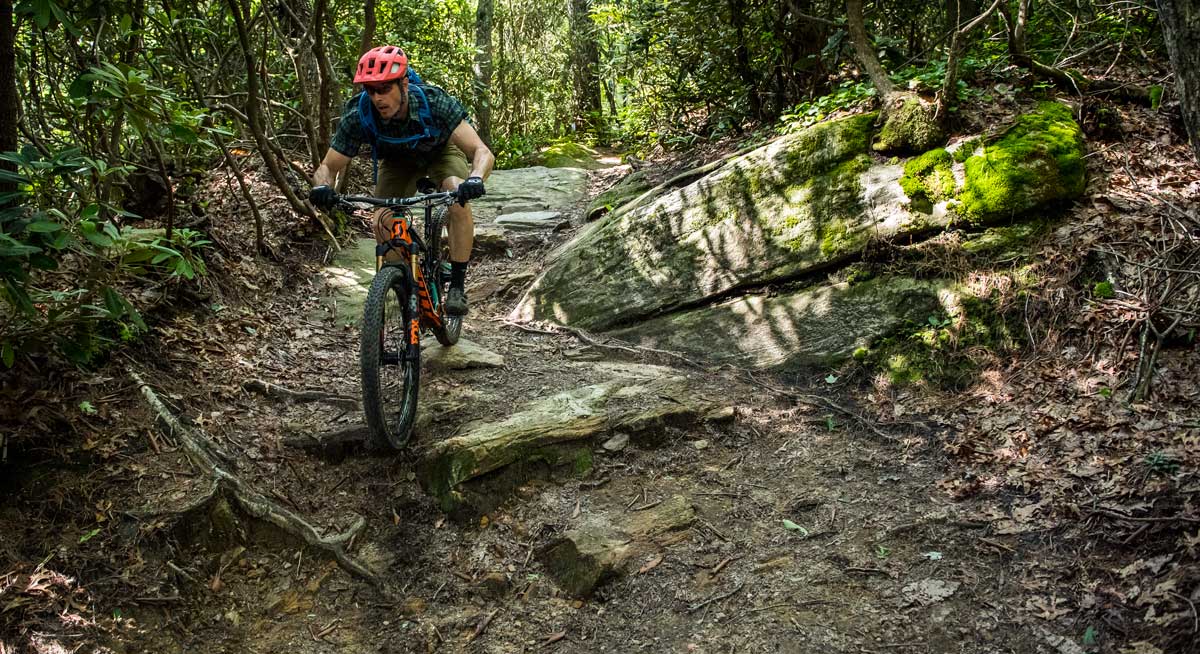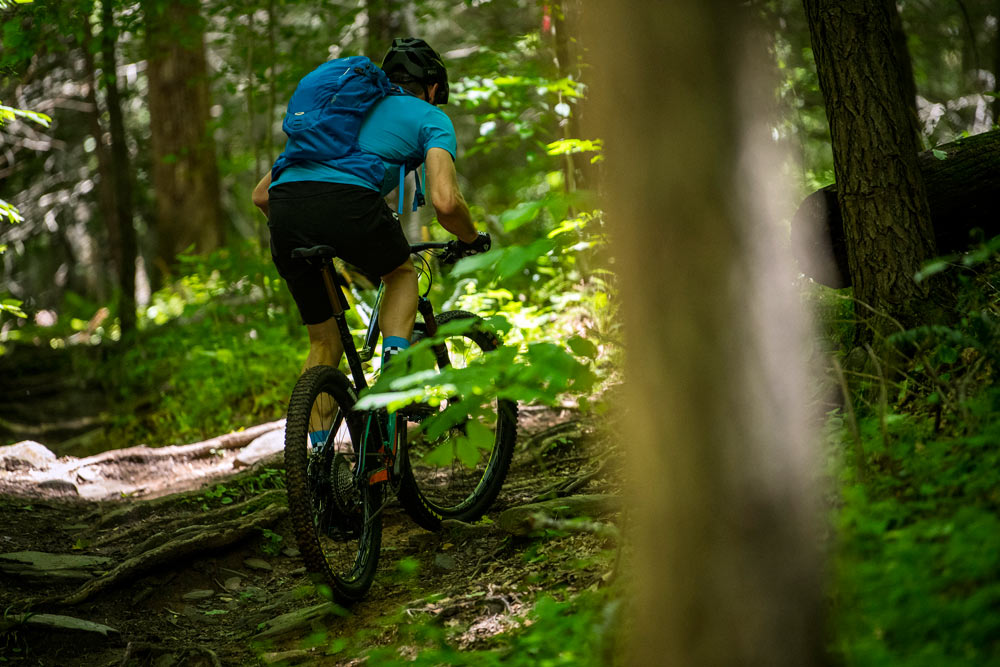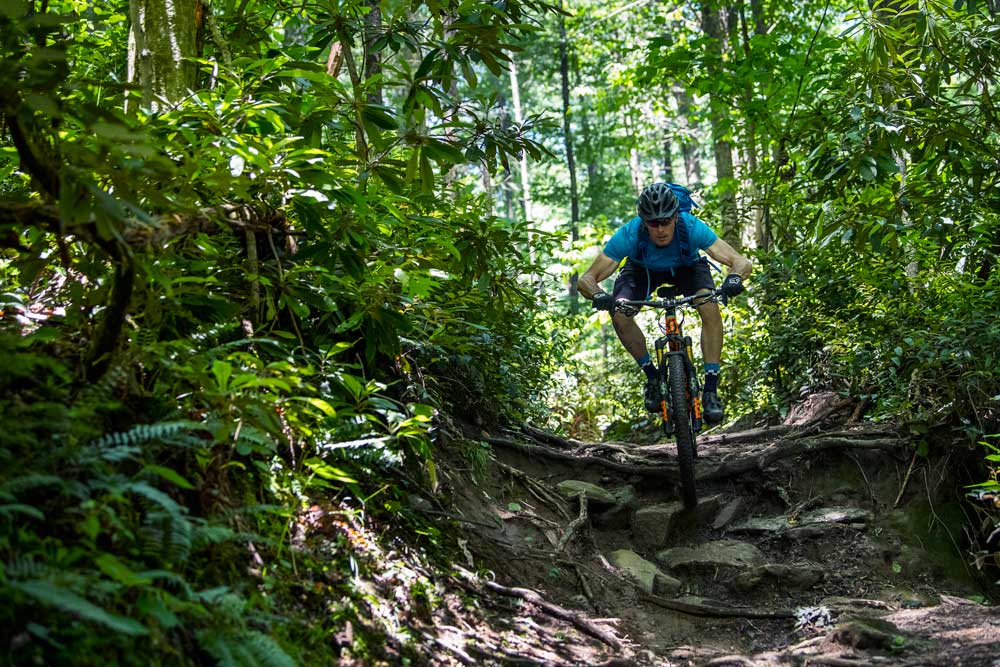The new Fox Live Valve electronic automatic compression damping system is one of those rare products that lives up to the hype. When we first showed up for the ride camp near Asheville, North Carolina, Fox’s reps suggested we start the ride with the system on. Set in the middle of it’s sensitivity curve, that gave us the opportunity to see how it performed on a variety of climbs and descents. Then we turned it off…
The first thing I realize when starting to ride any new suspension item is that I’m looking for things to hit. Anything. Going out of my way to ride over every little rock, root, divot and bump. Eventually, that wears off, which is when the magic of good suspension technology becomes most apparent…in that it disappears. And that was the goal of having us ride it with the system on first, because only after it had disappeared under us could we full appreciate it when it actually disappeared.
If you want to recreate the feeling, put your suspension in its trail (middle setting), then just go ride your usual lap. Then set everything wide open and do the same thing. For the climbs, traverses and descents. That will get you about 40% of the way toward what Fox Live Valve does, and it’ll show you why that mid-setting support and damping is so valuable on the climbs and traverses. And it’ll reinforce why you want the suspension open on the descents.
Where the Live Valve system fills in that last 60% to be 100% awesome is that it switches between a more efficient climbing/traversing mode and wide open instantly and automatically. Which is how it disappears under you and just lets you concentrate on riding.
It starts with a climb…
As with most rides, things start with a climb. Fox had to climb a huge technological hurdle to create Live Valve, a journey we documented with all the tech detail in our launch story. And I’m glad they did, because even though the price of this system puts it out of most people’s reach for now, it’s the kind of tech that’ll force everyone (Fox included) to find ways of putting it on more affordable bikes.
As far as actual on-the-bike climbing, it’s there and in the flat, flowy, traversy sections of trail where the system will really shine for most riders. In the two photos directly above, we were climbing rooty, rocky lines that benefited from a suspension’s ability to keep the wheel stuck to the ground.
Step ups, big roots and other obstacles can often mess up a nice seated pedaling rhythm. But you want a generally firm suspension so you’re not bobbing around on the the rest of the climb. So, having a suspension that automatically opens up to absorb the bump, means all of your energy can go into forward propulsion rather than wiggling around those obstacles or popping the front wheel up. Fox’s system does all of this, and thanks to its pitch detection, it knows to time the valve’s opening so that the rear doesn’t open at the same time as the front, delaying it until about the time it’s likely to hit the same obstacle. This is important, particularly on longer travel bikes, because if the rear opened too quickly, you’d sag into the travel before the impact, which would just feel weird. That doesn’t happen, though, and the effect is smoother, grippier climbing.
…and continues on the descent
When it comes time to descend, the system basically just opens up as long as you’re hitting stuff. The pitch detection knows your pointed down (the angle of which is determined by the bike manufacturer and Fox and is factory set), so it speeds up the timing between front and rear, but also increases the time before the valve closes again. So for repetitive hits and in situations where it’s not likely you’re pedaling, it’ll remain open to be as plush as possible.
It also knows when you’re dropping off a ledge or jumping and opens the system to absorb the landing impact. And it does this surprisingly well. Even a small 4″ drop was cushioned, then the system immediately firmed up again to sprint away. Whether it was the landing impact itself or the free fall detection that solved that is irrelevant, it worked quickly enough. Which brings up an important point for enduro and downhill use: When fractions of a second count and you need to sprint between rough sections, Live Valve will literally work to help you gain time with no rider input needed. Meaning, you won’t need to take your thumbs off the bar to push a lever. Sponsored pro enduro rider Greg Callaghan said he gained two seconds on his best time on his first use of it, and that’s enough to win a lot of races at the top level. We took a look at Greg’s Stereo 150 just a week ago, but guess we’ll see his new Live Valve equipped Cube for the next EWS stop.
Fox Live Valve In Action
Above, Fox’s official launch video. Below, our tech run thru with a bit of riding footage at the end, which (watch it full screen on something large) shows how much damping control it offers when standing and pedaling, then immediately opens up when bashing over a fallen tree branch.
Fox Live Valve First Riding Impressions
Does this make you a lazy rider? Not any more than just having suspension does. It really just frees you up to enjoy the ride more rather than wondering if your suspension is in the right mode. Or suffering the consequences when you forget to switch it to the right mode.
Where as perhaps before you might have found a middle ground position that compromised between firm enough for pedaling without being too stiff on downhills or rough sections. Now, you can optimize around being the most sensitive to bumps to keep you riding faster on the gnarly stuff, and take advantage of a firmer platform when pedaling. Ideally, you won’t notice the system working, you’ll just have a better ride.



